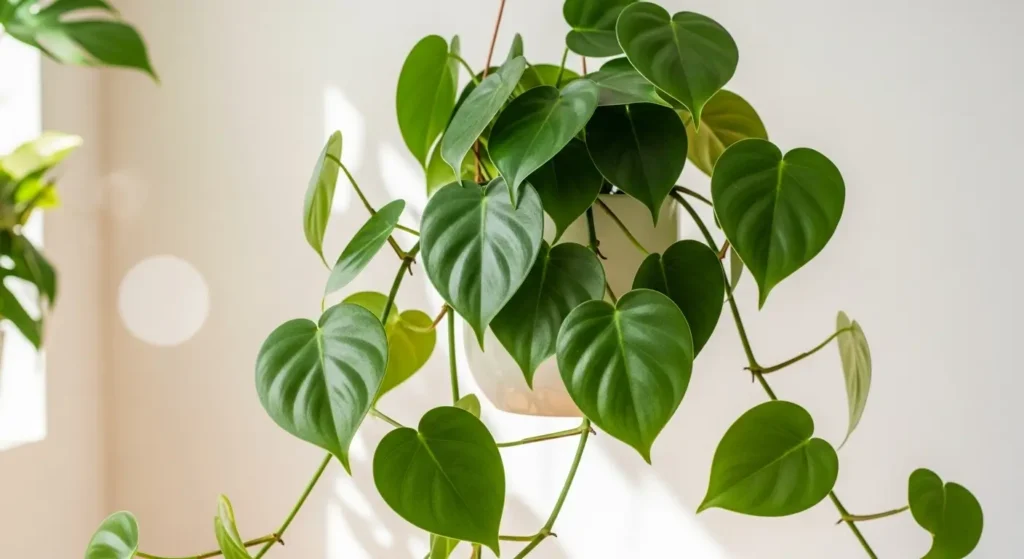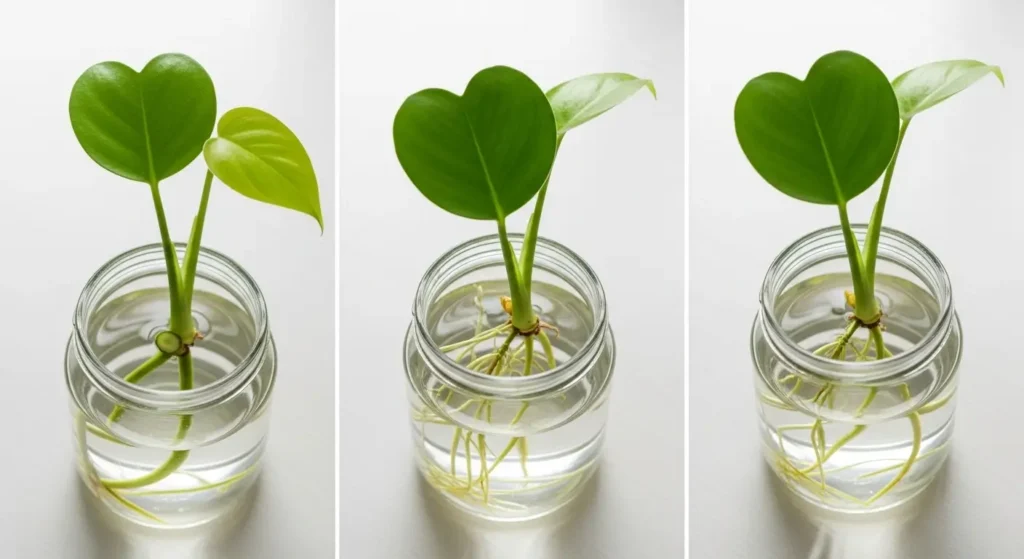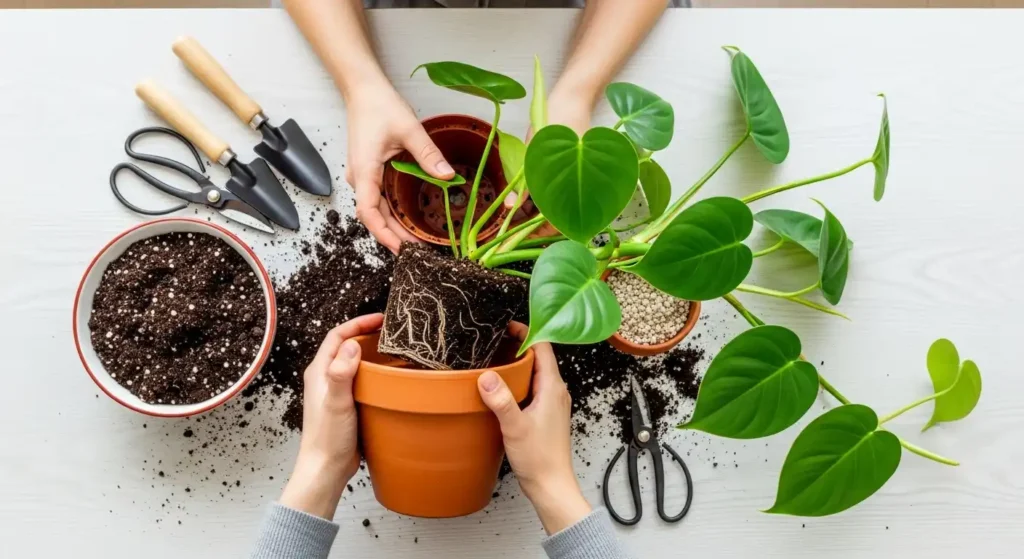
In This Article
The heart leaf philodendron is one of the easiest houseplants you’ll ever grow. Its glossy, heart-shaped leaves cascade beautifully from hanging baskets or climb up moss poles with minimal effort. Native to the tropical rainforests of Central America and the Caribbean, Philodendron hederaceum has been a favorite indoor plant for decades. Honestly, if you can keep a cactus alive, you can definitely grow this forgiving tropical beauty. This low-maintenance plant thrives in typical household conditions and tolerates occasional neglect better than most houseplants.
Plant Care Card
| Attribute | Details |
|---|---|
| Common Name | Heart Leaf Philodendron, Sweetheart Plant |
| Botanical Name | Philodendron hederaceum |
| Family | Araceae |
| Plant Type | Perennial, tropical vine |
| Mature Size | 4-6 feet long (indoors) |
| Sun Exposure | Bright indirect light |
| Soil Type | Well-draining potting mix |
| Soil pH | 5.5-6.5 (slightly acidic) |
| Hardiness Zones | 10-12 (USDA) |
| Native Area | Central America, Caribbean |
| Toxicity | Toxic to pets and humans |
Heart Leaf Philodendron Care
This plant is perfect for beginners because it’s super forgiving with care mistakes. The following sections will cover everything you need to know about light, water, soil, and more. You’ll love how easy it is to keep this beauty thriving indoors!
Light
Heart leaf philodendron thrives in bright, indirect light but adapts surprisingly well to lower light conditions. Place it near an east or north-facing window where it gets gentle morning sun or filtered light throughout the day. Too much direct sunlight will scorch those gorgeous leaves, turning them yellow or brown. On the other hand, insufficient light causes leggy growth with smaller leaves spaced far apart.
If you notice the vines stretching toward the light source, that’s your cue to move it closer to a window. Additionally, these plants can tolerate fluorescent office lighting, making them perfect for workspaces.
Soil
The ideal potting mix for this plant is light, airy, and drains quickly after watering. A standard houseplant potting mix works fine, but mixing in some perlite or orchid bark improves drainage significantly. According to Penn State Extension, well-draining soil prevents root rot and provides plants with easy access to air, water, and nutrients.
You can create your own mix using 2 parts peat moss, 1 part perlite, and 1 part pine bark. This combination holds moisture without becoming waterlogged, which is exactly what tropical plants need.
Water
Watering correctly is probably the most important aspect of heart leaf philodendron care. Let the top 2-3 inches of soil dry out before watering again stick your finger in the soil to check. When you do water, drench the soil thoroughly until water runs out the drainage holes, then empty any excess from the saucer.
Overwatering causes yellowing leaves and root rot, while underwatering leads to drooping, crispy leaf edges. During spring and summer when growth is active, you’ll water more frequently. In fall and winter, reduce watering as the plant’s growth slows down. Just like with neon pothos, consistent moisture without sogginess is key to healthy growth.
Temperature and Humidity
This tropical plant prefers temperatures between 65-80°F, which is perfect for most homes. It tolerates slightly cooler temps but suffers if exposed to anything below 55°F. Keep your philodendron away from cold drafts, air conditioning vents, and heating registers.
While heart leaf philodendron adapts to average household humidity, it appreciates levels above 40%. If your home is particularly dry, especially during winter, consider misting the leaves occasionally or placing the pot on a pebble tray filled with water.
Fertilizer
Feed your heart leaf philodendron with a balanced liquid fertilizer diluted to half strength every 4-6 weeks during spring and summer. A standard 20-20-20 formula works perfectly for maintaining healthy growth. Stop fertilizing in fall and winter when the plant naturally slows its growth. Overfertilizing causes salt buildup in the soil and can burn the roots.
Propagating Heart Leaf Philodendron
The best time to propagate is during spring and summer when the plant is actively growing.
Propagating by Stem Cuttings in Water

Water propagation is the easiest and most popular method for multiplying your heart leaf philodendron. You’ll see roots develop quickly, and it’s honestly kind of addicting to watch!
Materials needed:
- Clean, sharp scissors or pruning shears
- Glass jar or vase with water
- Rooting hormone (optional)
Steps:
- Cut a 4-6 inch stem section just below a node (where leaves attach), making sure it has at least 2-3 leaves attached to the cutting.
- Remove the bottom 1-2 leaves so they won’t rot underwater, leaving only the top leaves above the water line.
- Place the cutting in a jar of room temperature water, ensuring the node is submerged completely while leaves stay dry above water.
- Change the water every 3-4 days to keep it fresh and prevent bacterial growth, and roots should appear within 2-3 weeks.
- Once roots reach 2-3 inches long, transfer the cutting to a pot with fresh potting mix and keep the soil consistently moist.
Propagating by Stem Cuttings in Soil
Direct soil propagation takes slightly longer but creates stronger root systems from the start.
Steps:
- Take 4-6 inch stem cuttings with 2-3 nodes, cutting just below a node with clean shears.
- Dip the cut end in rooting hormone to speed up root development (optional but helpful).
- Insert the cutting 1-2 inches deep into moist potting mix, firming the soil gently around the stem.
- Cover with a clear plastic bag to maintain humidity, and place in bright indirect light away from direct sun.
Roots develop in 3-4 weeks. Similar propagation methods work well for philodendron brasil, another easy-care trailing philodendron.
Potting and Repotting Heart Leaf Philodendron

Heart leaf philodendron grows slowly and only needs repotting every 2-3 years. You’ll know it’s time when roots emerge from drainage holes, the soil dries out much faster than usual, or growth becomes stunted despite proper care.
Choose a pot only 1-2 inches larger in diameter than the current one. Gently remove the plant, loosen the root ball slightly, and place it in the new pot with fresh potting mix. Water thoroughly after repotting and avoid fertilizing for 4-6 weeks to let the roots adjust.
Make sure your pot has drainage holes this is non-negotiable for preventing root rot. Terracotta pots work wonderfully because they allow soil to dry out more evenly.
Common Pests and Diseases
Like most houseplants, heart leaf philodendron can occasionally attract pests, but these are easy to manage when caught early.
Spider Mites
Look for tiny webs on leaf undersides and stippled yellow spots on foliage indicating spider mite damage. Treat with insecticidal soap or neem oil spray, wiping leaves thoroughly every 3-5 days until mites disappear completely.
Mealybugs
These white, cottony insects cluster in leaf axils and on stems, sucking plant sap. Remove with cotton swabs dipped in rubbing alcohol, or spray with diluted neem oil weekly until infestation clears.
Scale Insects
Brown, oval bumps stuck to stems and leaves are scale insects that drain plant nutrients slowly. Scrape them off with your fingernail or a soft brush, then treat with horticultural oil spray or insecticidal soap.
Aphids
Small green, black, or white insects cluster on new growth, causing distorted leaves and sticky residue. Rinse plants with lukewarm water or spray with insecticidal soap to eliminate aphids quickly and effectively.
Common Problems with Heart Leaf Philodendron
Here’s how to troubleshoot common issues:
Yellow Leaves
This is usually caused by overwatering, which suffocates the roots and prevents nutrient uptake properly. Check if the soil feels soggy and reduce watering frequency immediately. Yellow leaves can also indicate a nitrogen deficiency if the plant hasn’t been fertilized recently start feeding monthly. Occasionally, lower leaves naturally yellow and drop as the plant ages, which is completely normal.
If only new growth turns yellow while veins stay green, it’s iron chlorosis from soil pH issues. Adjust soil pH or use chelated iron supplements. Just like with spider plant care, proper watering prevents most yellowing issues.
Brown Leaves or Brown Leaf Tips
Low humidity is the most common culprit for brown, crispy leaf tips in heart leaf philodendron. Increase humidity by misting, using a humidifier, or grouping plants together. Tap water high in fluoride or chlorine also causes brown tips—switch to filtered or distilled water. Underwatering leads to brown, papery edges along entire leaves, so check soil moisture regularly.
Drooping or Wilting Leaves
Inconsistent watering causes leaves to droop dramatically, whether from too much or too little water. Feel the soil if it’s bone dry, water thoroughly and the plant should perk up within hours. However, if soil is soggy and leaves still droop, root rot is likely and you’ll need to repot immediately. Similar drooping issues occur with peperomia plants when watering is inconsistent.
Leggy Growth or Sparse Foliage
Insufficient light causes vines to stretch out with long spaces between leaves and smaller foliage overall. Move your plant closer to a bright window, but avoid direct sunlight which burns leaves. Prune back leggy stems to encourage bushier, more compact growth from the base.
FAQ
How do you take care of a heart leaf philodendron?
Provide bright indirect light, water when the top 2-3 inches of soil dry out, and fertilize monthly during growing season. Keep temperatures between 65-80°F and maintain moderate humidity.
Do heart leaf philodendrons climb or hang?
They naturally climb in the wild using aerial roots, but indoors they’re typically grown as trailing plants in hanging baskets. You can also train them to climb a moss pole or trellis.
How toxic is heart leaf philodendron?
All parts contain calcium oxalate crystals that are toxic to pets and humans, causing mouth irritation, drooling, and stomach upset if ingested. Keep away from curious pets and children.
Is a heart leaf philodendron a pothos?
No, they’re different species despite looking similar with their trailing vines and heart-shaped leaves. Philodendrons have softer, thinner leaves while pothos leaves are thicker and waxy.

1 thought on “Heart Leaf Philodendron : The Ultimate Care & Growing Guide”
Comments are closed.